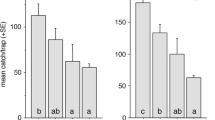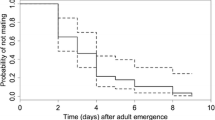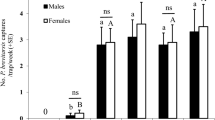Abstract
Behavioral responses of male and female boll weevils to the aggregation pheromone, grandlure, and the major volatile of cotton, β-bisabolol, were investigated using a new dual-choice olfactometer. Dosage-response experiments revealed both males and females to be attracted by the aggregation pheromone at the 1.0 μg dosage. However, only males were attracted to β-bisabolol (1.0 μg). Both sexes were repelled by the highest dosage ofβ-bisabolol tested (10 μg). In preference experiment, males chose grandlure over β-bisabolol, while both sexes chose the combination of grandlure + β-bisabolol over β-bisabolol alone. There was some evidence for synergism between pheromone and plant odor for the females. The results correlate well with previous electrophysiological and behavioral experiments.
Similar content being viewed by others
References
Bell, W.J. andCardé, R.T. (eds.) 1984. Chemical Ecology of Insects. Sinauer Associates, Sunderland, Massachusetts, xvi + 524 pp.
Birch, M. C. 1984. Aggregation in bark beetles, pp. 331–353,in W.J. Bell and R.T. Cardé (eds.) Chemical Ecology of Insects. Sinauer Associates, Sunderland, Massachusetts.
Cross, W.H. 1973. Biology, control, and eradication of the boll weevils.Annu. Rev. Entomol. 18:17–46.
Cross, W.H. 1983. Ecology of cotton insects with special reference to the boll weevil, pp. 53–70,in R.L. Ridgway, E.P. Lloyd, and W.H. Cross (eds.). Cotton Insect Management with Special Reference to the Boll Weevil. U.S. Department of Agriculture Handbook No. 589.
Dickens, J.C. 1984. Olfaction in the boll weevil,Anthonomus grandis Boh. (Coleoptera: Curculionidae): Electroantennogram studies.J. Chem. Ecol. 10:1759–1785.
Gueldner, R.C., andWiygul, G. 1978. Rhythms in pheromone production of the male boll weevil.Science 199:984–986.
Gutmann, A., Payne, T.L., Roberts, E.A., Shulte-Elte, K.H., Giersch, W., andOhloff, G. 1981. Antennal olfactory response of the boll weevil to grandlure and vicinal dimethyl derivatives.J. Chem. Ecol. 7:919–926.
Hardee, D.D., Mitchell, E.B., Huddleston, P.M., andDavich, T.B. 1966. A laboratory technique for bioassay of plant attractants for the boll weevil.J. Econ. Entomol. 59:240–241.
Hardee, D.D., Mitchell, E.B., andHuddleston, P.M. 1967. Procedure for bioassaying the sex attractant of the boll weevil.J. Econ. Entomol. 60:169–171.
Hardee, D.D. Cross, W.H., andMitchell, E.B. 1969. Male boll weevils are more attractive than cotton plants to boll weevils.J. Econ. Entomol. 62:165–169.
Hardee, D.D., McKibben, G.H., Gueldner, R.C., Mitchell, E.B., Tumlinson, J.H., andCross, W.H. 1972. Boll weevils in nature respond to grandlure, a synthetic pheromone.J. Econ. Entomol. 65:97–100.
Hedin, P.A., McKibben, G.H., Mitchell, E.B., andJohnson, W.L. 1979. Identification and field evaluation of the compounds comprising the sex pheromone of the female boll weevil.J. Chem. Ecol. 5:617–627.
Hunter, W.D., andPierce, W.D. 1912. The Mexican cotton boll weevil. U.S.D.A. Bur. Entomol. Bull. No. 114, 118pp.
Keller, J.C., Davich, T.B., Maxwell, F.G., Jenkins, J.N., Mitchell, E.B., andHuddleston, P. 1965. Extraction of a boll weevil attractant from the atmosphere surrounding growing cotton.J. Econ. Entomol. 58:588–589.
Mckibben, G.H., Mitchell, E.B., Scott, W.P., andHedin, P.A. 1977. Boll weevils are attracted to volatile oils from cottom plants.Environ. Entomol. 6:804–806.
Minyard, J.P., Hardee, D.D., Gueldner, R.C., Thompson, A.C., Wiygul, G., andHedin, P.A. 1969. Constituents of the cotton bud. Compounds attractive to the boll weevil.Agric. Food Chem. 17:1093–1097.
Mistric, W.J., Jr., andMitchell, E.R. 1966. Attractiveness of isolated groups of cotton plants to migrating boll weevils.J. Econ. Entomol. 59:39–41.
Mitchell, E.R., andTaft, H.M. 1966. Host-plant selection by migrating boll weevils.J. Econ. Entomol. 59:390–392.
Ostle, B. 1969. Statistics in Research. Iowa State University Press, Ames, Iowa, xv + 585 pp.
Parencia, C.R., Jr., Davis, J.W. andCowan, C.B., Jr. 1964. Studies on the ability of overwintered boll weevils to find fruiting cotton plants.J. Econ. Entomol. 57:162.
Smith, G.L., Cleveland, T.C., andClark, T.C. 1965. Boll weevil movement from hibernation sites to fruiting cotton.J. Econ. Entomol. 58:357–358.
Thompson, A.C., Wright, B.J., Hardee, D.D., Gueldner, R.C., andHedin, P.A. 1970. Constituents of the cotton bud. XVI. The attractancy response of the boll weevil to the essential oils of a group of host and nonhost plants.J. Econ. Entomol. 63:751–753.
Thompson, A.C., Hanny, B.W., Hedin, P.A., andGueldner, R.C. 1971. Phytochemical studies in the family Malvaceae. I. Comparison of essential oils of six species by gas-liquid chromatography.Am. J. Bot. 58:803–807.
Tumlinson, J.H., Hardee, D.D., Gueldner, R.C., Thompson, A.C., Hedin, P.A., andMinyard, J.P. 1969. Sex pheromones produced by male boll weevils: Isolation, identification, and synthesis.Science 166:1010–1012.
Author information
Authors and Affiliations
Additional information
Mention of a trademark, proprietary product, or vendor does not constitute a guarantee or warranty of the product by the U.S. Department of Agriculture and does not imply its approval to the exclusion of other products or vendors that may also be suitable.
Rights and permissions
About this article
Cite this article
Dickens, J.C. Orientation of boll weevil,Anthonomus grandis boh. (Coleoptera: Curculionidae), to pheromone and volatile host compound in the laboratory. J Chem Ecol 12, 91–98 (1986). https://doi.org/10.1007/BF01045593
Received:
Accepted:
Issue Date:
DOI: https://doi.org/10.1007/BF01045593




